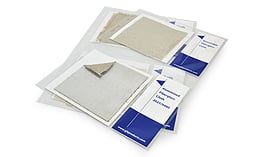
Often, at GLT Products, we are questioned about PVC Jacketing. As you might imagine, the most common question asked is, “what is it?”
Let’s start with PVC: PVC stands for Poly Vinyl Chloride. PVC is the third most widely produced synthetic plastic polymer. It comes in two basic forms, rigid and flexible. PVC in its rigid form is made into a variety of products from pipe to windows, bottles to bank cards. Flexible PVC is often used to replace rubber. For the protection of pipe insulation, PVC is produced into sheets as thin as .010” and as thick as .040”. It not only protects the insulation it is designed to cover but it also provides a neat, glossy, attractive finish.
“Why is it used?” PVC has good chemical resistance and is an ideal product to be used when protecting insulation in process facilities requiring wash-downs. Unlike metal jacketing systems, it allows for a totally sealed system that will prevent the possibility of water or chemical attack on the insulation.
PVC Jacket is cut to size so that it will fit a desired outside diameter pipe after it has been insulated. The jacket can be supplied in 3’ or 4’ pieces. Pieces are supplied with an overlap allowing for weld adhesives or self sealing lap tape.
“How is it applied?” This depends on what you are trying to accomplish. In a commercial setting, not needing to meet the rigorous demands of high temperature wash-downs, a simple taping method will suffice. The fabricator of cut and curled to size PVC jacket can provide the jacket with a self sealing lap tape (SSL Tape) already in place. Self Sealing Lap tape is a pressure sensitive double coated tape that has been applied to the jacket. When applying the jacket over the insulation, the strip of paper attached to the tape is removed. The edges are then pressed together and the adhesive holds the jacket in place. Jacketing that will be exposed to wash-downs is installed using solvent weld adhesive. Solvent Weld adhesive is a mild solvent, generally colored white, that melts a small layer of the PVC to itself thus creating a fully sealed system. The adhesive is applied with an applicator can equipped with a long nozzle that will fit under the overlap of the jacket. A bead of adhesive is delivered and the PVC is held in place until the jacket edges are “welded” together.
Over the past 30 years, PVC has become extremely popular as an insulation jacket. Due to its competitive pricing and ease of installation, specifiers and contractors have found it to be one of the best ways to protect pipe insulation. Most fabricators and distributors stock many sizes of PVC jacketing to meet project demands. Contracors unfamiliar with PVC should contact their supplier for advice on performance, application and installation.
In the U.S., .020” thick PVC is generally required for indoor use. Outdoor applications or high impact areas might require thicker PVC. Canadian specifiers are typically using .015” thick PVC for indoor use.


